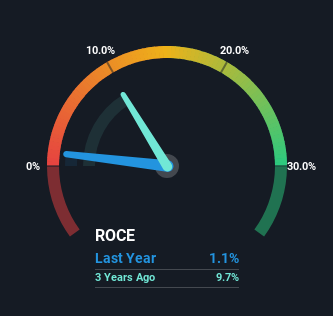- United States
- /
- Basic Materials
- /
- NasdaqCM:SMID
Smith-Midland (NASDAQ:SMID) Might Be Having Difficulty Using Its Capital Effectively
If we want to find a stock that could multiply over the long term, what are the underlying trends we should look for? One common approach is to try and find a company with returns on capital employed (ROCE) that are increasing, in conjunction with a growing amount of capital employed. If you see this, it typically means it's a company with a great business model and plenty of profitable reinvestment opportunities. However, after briefly looking over the numbers, we don't think Smith-Midland (NASDAQ:SMID) has the makings of a multi-bagger going forward, but let's have a look at why that may be.
Return On Capital Employed (ROCE): What Is It?
If you haven't worked with ROCE before, it measures the 'return' (pre-tax profit) a company generates from capital employed in its business. Analysts use this formula to calculate it for Smith-Midland:
Return on Capital Employed = Earnings Before Interest and Tax (EBIT) ÷ (Total Assets - Current Liabilities)
0.011 = US$502k ÷ (US$58m - US$13m) (Based on the trailing twelve months to September 2023).
So, Smith-Midland has an ROCE of 1.1%. Ultimately, that's a low return and it under-performs the Basic Materials industry average of 11%.
See our latest analysis for Smith-Midland

Historical performance is a great place to start when researching a stock so above you can see the gauge for Smith-Midland's ROCE against it's prior returns. If you'd like to look at how Smith-Midland has performed in the past in other metrics, you can view this free graph of past earnings, revenue and cash flow.
What Can We Tell From Smith-Midland's ROCE Trend?
When we looked at the ROCE trend at Smith-Midland, we didn't gain much confidence. Over the last five years, returns on capital have decreased to 1.1% from 3.8% five years ago. However, given capital employed and revenue have both increased it appears that the business is currently pursuing growth, at the consequence of short term returns. If these investments prove successful, this can bode very well for long term stock performance.
Our Take On Smith-Midland's ROCE
Even though returns on capital have fallen in the short term, we find it promising that revenue and capital employed have both increased for Smith-Midland. And long term investors must be optimistic going forward because the stock has returned a huge 302% to shareholders in the last five years. So should these growth trends continue, we'd be optimistic on the stock going forward.
If you want to continue researching Smith-Midland, you might be interested to know about the 2 warning signs that our analysis has discovered.
For those who like to invest in solid companies, check out this free list of companies with solid balance sheets and high returns on equity.
New: Manage All Your Stock Portfolios in One Place
We've created the ultimate portfolio companion for stock investors, and it's free.
• Connect an unlimited number of Portfolios and see your total in one currency
• Be alerted to new Warning Signs or Risks via email or mobile
• Track the Fair Value of your stocks
Have feedback on this article? Concerned about the content? Get in touch with us directly. Alternatively, email editorial-team (at) simplywallst.com.
This article by Simply Wall St is general in nature. We provide commentary based on historical data and analyst forecasts only using an unbiased methodology and our articles are not intended to be financial advice. It does not constitute a recommendation to buy or sell any stock, and does not take account of your objectives, or your financial situation. We aim to bring you long-term focused analysis driven by fundamental data. Note that our analysis may not factor in the latest price-sensitive company announcements or qualitative material. Simply Wall St has no position in any stocks mentioned.
About NasdaqCM:SMID
Smith-Midland
Smith-Midland Corporation invents, develops, manufactures, markets, leases, licenses, sells, and installs various precast concrete products and systems.
Outstanding track record with flawless balance sheet.
Market Insights
Weekly Picks

Early mover in a fast growing industry. Likely to experience share price volatility as they scale


A case for CA$31.80 (undiluted), aka 8,616% upside from CA$0.37 (an 86 bagger!).


Moderation and Stabilisation: HOLD: Fair Price based on a 4-year Cycle is $12.08
Recently Updated Narratives

A Quality Compounder Marked Down on Overblown Fears

Etsy Stock: Defending Differentiation in a World of Infinite Marketplaces

Align Technology Stock: Premium Orthodontics in a Cost-Sensitive World
Popular Narratives


A case for CA$31.80 (undiluted), aka 8,616% upside from CA$0.37 (an 86 bagger!).

Early mover in a fast growing industry. Likely to experience share price volatility as they scale


NVDA: Expanding AI Demand Will Drive Major Data Center Investments Through 2026
Trending Discussion



